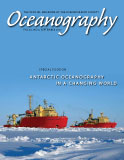Article Abstract
The goal of the ICEFISH 2004 cruise, which was conducted on board RVIB Nathaniel B. Palmer and traversed the transitional zones linking the South Atlantic to the Southern Ocean, was to compare the evolution, ecology, adaptational biology, community structure, and population dynamics of Antarctic notothenioid fishes relative to the cool/temperate notothenioids of the sub-Antarctic. To place this work in a comprehensive ecological context, cruise participants surveyed the benthos and geology of the biogeographic provinces and island shelves on either side of the Antarctic Polar Front (or Antarctic Convergence). Genome-enabled comparison of the responses of cold-living and temperate notothenioids to heat stress confirmed the sensitivity of the former to a warming Southern Ocean. Successful implementation of the international and interdisciplinary ICEFISH research cruise provides a model for future exploration of the sub-Antarctic sectors of the Indian and Pacific Oceans.

